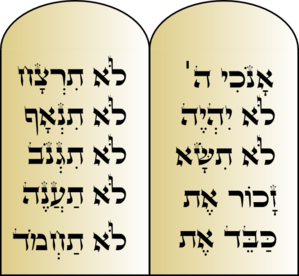In this week’s parsha, Parshas Yisro, Klal Yisrael hear the Aseres Hadibros, the Ten Commandments, as they embraced their lofty mission in this world. We are commanded to treat every parsha, pasuk, and word in the Torah with equal awe and respect, and yet there is a prevailing custom to stand in shul as the Aseres Hadibros are read, seemingly attributing unique significance to them. The Aseres Hadibros are carved above the Aron in almost every shul, and we view them as the foundation of the Torah. What is it about these words that merit special treatment? In order to understand the apparent centrality and importance of these Ten Commandments, we must delve into their deeper meaning.
Two Sets of Luchos
Why are the luchos split into two separate groups, the right side and the left side? Why fragment the ultimate expression of oneness into two separate groups?
The commentaries explain that while the right side of the luchos contain mitzvos bein adam l’Makom (commandments between man and God) the mitzvos on the left side are bein adam l’chaveiro (between man and his fellow man). There are layers of meaning behind this specific breakup. The simplest lesson is that it is equally important to treat our fellow man properly and to serve Hashem. The deeper meaning of this parallel is that each and every human being is a tzelem Elokim, an extension and expression of Hashem in this world. While mitzvos bein adam l’Makom keep us on track on our individual journey back to Hashem, the mitzvos bein adam l’chavero inspire within us the understanding that we are part of a higher interconnected self, Klal Yisrael, and we as a whole are a reflection of Hashem in this world.
The Parallel Between the Two Luchos
While the general juxtaposition of the mitzvos on the right and left sides of the luchos carry fundamental significance, there is a powerful connection between the commandments on each side as well. Each individual dibrah on the right parallels the corresponding dibrah on the left. Together, they make up a unified whole of connection both to Hashem and fellow man. Let us explore these connections in detail.
Anochi Hashem and Lo Tirtzach
The first dibrah is Anochi Hashem, the statement that establishes Hashem as the source of reality and life-force of the world. Accordingly, we must recognize this truth and commit to living a life faithful to this fundamental truth. The first dibrah on the left side of the luchos, and therefore parallel to the dibrah of Anochi Hashem, is lo tirtzach, the prohibition against murder. Hashem created each and every human being with a chelek Elokah mi’ma’al, (a spark of Godliness from above), and killing another human being means eliminating that spark from the world. Anochi Hashem expresses the ultimate source of life and existence, while murder is the ultimate shattering of existence.
From another perspective, the ability to take away life belongs only to the one who gives life. Murdering another person is claiming the power and authority to eliminate a person’s life, essentially claiming that I am Hashem, the controller of life. Accordingly, murder directly contradicts the truth of Anochi Hashem Elokecha, that Hashem alone is the source of this world and everything in it.
Avodah Zarah and Adultery
Once the primary principle of Anochi Hashem is established, the logical next step is ensuring that we are faithful to that truth.
Many think of idolatry as the worship of statues and inanimate objects. However, any intelligent person can see that a piece of wood or stone carved out by man himself could not possibly hold any power. The deeper understanding behind the worship of idolatry, as the Rambam (Mishnah Torah- Avodah Zarah- 1st chapter), Ramchal (Derech Hashem), and many others explain, is the worshiping of intermediaries, instead of sourcing yourself back to Hashem Himself. Hashem created the world in such a way that there are levels of reality. Hashem is the ultimate source, and the intermediaries receive energy from Him, and then manifest it into the world. Avodah zarah is when you don’t recognize Hashem as the source, but rather trace things back only as far as the intermediaries. The statues that people “worship” are merely tangible representations of the higher forces they are serving. Worshiping avodah zarahs betraying our true source for the intermediaries, the ultimate unfaithfulness to Hashem. Matan Torah established our marriage to Hashem, and idol worship is a betrayal to the commitment and connection of that marriage.
The prohibition against adultery is the corresponding dibrah on the left. Adultery is unfaithfulness in marriage, betraying the trust and loyalty integral to the relationship. Any illicit relationship is a breakdown of what a proper relationship represents; therefore avodah zarah and adultery are inherently connected.
Saying Hashem’s Name in Vain and Kidnapping
The third dibrah is the prohibition against uttering Hashem’s name in vain, while the sixth, corresponding dibrah is the prohibition against kidnapping (a form of stealing). The practical connection between the two is explained in the Mechiltah, which states that one who kidnaps will also have to swear falsely in order to cover his tracks.
There is a deeper connection between the two as well. When one testifies in court, he must swear using Hashem’s name. This is not merely a practical requirement but is also a reflection of the essence of Hashem’s name. Hashem’s name represents objective truth – the Gemara states that Hashem’s “signature” is emes, as Hashem is truth. When one swears falsely or says Hashem’s name in vain, he takes that which is transcendent and corrupts it, displacing it from its lofty, proper place. By using Hashem’s name in the context of that which is false or meaningless, a person connects Hashem to those falsehoods.
When one kidnaps someone, he does the same. He takes someone who was created b’tzelem Elokim, and displaces him, removes him from his proper status and place in the world, and treats him as an object. Just as displacing Hashem’s name from its proper lofty place shows a complete lack of respect for Hashem’s greatness (Ibn Ezra, Vayikra 19:12), kidnapping shows a complete disregard for humanity’s greatness.
Shabbos and False Testimony
The fourth dibrah on the right side of the luchos is remembering and guarding Shabbos, while the fourth dibrah on the left side is the prohibition against false testimony and lying in court.
The parallel between these two dibros is the use of testimony and speech. Shabbos is when we testify that Hashem created and runs the world, reconnecting ourselves to this truth and realigning any false perceptions we may have developed throughout the week. False testimony is a corruption of this principle, using testimony to bear false witness. It’s interesting that lying can only occur in this world, where hiddenness and deceit exist. In this world, one has the ability to pretend like something that exists does not exist, and vice versa. In the World to Come, however, everything will be transparent and clear, lying will be impossible, and truth will permeate everything. This is why the Gemara (Brachos 57a) compares Shabbos to Olam Habah- The World to Come. Shabbos connects us to the ultimate truth, to our ultimate destination, to a state of absolute clarity. It connects us back to creation, and simultaneously, towards our ultimate destination. Even deeper, though, it also connects you to who you are right now, allowing you to fully experience who you’ve become, to fully experience your own internal truth.
Kibud Av V’Eim and Lo Sachmod (Jealousy)
Before comparing the last two dibros, we must first address an apparent problem with one of them. Kibud av v’em, the commandment to honor one’s parents, is the fifth commandment, the last of those on the right side of the luchos. However, the right side of the luchos is reserved for mitzvos bein adam l’Makom (between man and God) and while it may not always seem so, parents are human too. Why, then, is the mitzvah of honoring one’s parents located on the right side of the luchos?
The right side of the luchos contains the mitzvos bein adam l’Makom, but the deeper theme of the right side is mitzvos between man and his source (bein adam l’Mekor). The first four are bein Adam l’Makom, between man and his ultimate source, while the fifth, kibud av v’eim, is a mitzvah between man and his more immediate source, his parents. This juxtaposition reveals a deep connection between these mitzvos: The first step towards tracing oneself back to Hashem is recognizing that I am not my own creator, that I have a source. Kibud av v’eim is the first step towards doing so. Recognizing our parents as our source is the first step in tracing ourselves back to our ancestors, then to Avraham, then to Noach, eventually all the way back to Adam Ha’Rishon, until finally, we get back to Hashem Himself. In doing so, we trace our individual existence back to Hashem’s creation of the world itself. As such, Kibud Av v’Eim serves as the perfect transition between bein adam la’makom and bein adam la’chaveiro, as this mitzvah that serves as the springboard for the connection between you and Hashem. Recognizing that someone created us will help train us to source everything in our lives back to Hashem. However, the problems continue once we get to lo sachmod (jealousy). What is the connection between kibud av v’eim and the commandment of lo sachmod?
The answer to this question requires us to understand the reasoning behind the prohibition against jealousy. This commandment does not simply mandate an action, it is a mandate to live a life without any trace of jealousy. How is this possible?
When we understand that every single aspect of our life is given to us in order to help us fulfill our unique purpose in life, jealousy becomes nonsensical and what other people have becomes almost irrelevant. We were each given our unique talents, drives, and mission, and we have exactly what we need to fulfil it. Nothing that someone else has is essential for your mission, and no other person can achieve your purpose for you. Hashem gave you your mission and also gave you all the tools necessary to accomplish it. Instead of being jealous, we must focus on maximizing our time in this world to fulfill our unique potential.
Additionally, we aren’t competing with each other. If we realized that we are all part of the same team, the same self, the same people, we would never be jealous of one another. On the contrary, we would celebrate each other’s victories as our own!
This is what kibud av v’eim teaches us: the importance of tracing everything in your life back to its source, to Hashem. When we realize that our entire existence in this world, and all of the circumstances and challenges that we face, come from Hashem, there is no place for jealousy, as Hashem has given each of us the exact tools we need to succeed in our mission.
Engrave Them on Your Heart
When we picture the luchos, we automatically conjure up an image of two rounded tablets. However, the Gemara explicitly states that the luchos were cubic or rectangular. If so, why does every shul depict the luchos with two rounded tops, as an almost heart shaped figure?
The answer is that the luchos are intrinsically connected to the heart. The Aseres Hadibros are the heart of the Torah, and we are told to engrave them into our hearts, “kasvem al luach libecha” (Mishlei 7:3). This idea touches upon the unique nature of the luchos and how they were written.
There are four possible ways to write down an idea. The first is to use an adhesive, such as glue, paste, or tape, to attach the message to the medium. This is the weakest form of writing, as the message remains separate from the medium and can easily be erased or removed. The second is to use ink on paper. When doing so, the message is not as easily removed, as the message becomes more connected to the medium itself. However, the ink still remains on top, separate from the medium (the paper). It is the very contrast of the ink to the blank paper that allows you to understand the message. The third is to engrave the message into the medium itself. As such, the message becomes part of the medium itself and cannot be erased. However, there is a deeper form of writing, which is to bore the message completely through the medium, whereby the message becomes one with the medium itself.
This fourth level is how the luchos were written. The passuk says (Shemos 32:15) that the letters of the luchos were engraved through the stone and could miraculously be read both on the front and through the back of the tablets. Chazal discuss the miraculous way in which letters such as the samech and mem sofit both had middle pieces that floated in the air, disconnected from any other part of the stone.
This is the deep message of the luchos. We must engrave their words into our hearts, we must become one with the medium, we must become one with these mitzvos. We can’t be people who perform the mitzvos, we must become the mitzvos. May we be inspired to fully embrace Matan Torah this year, and merit to fulfil the directive of “Kasvem al luach libecha.”







